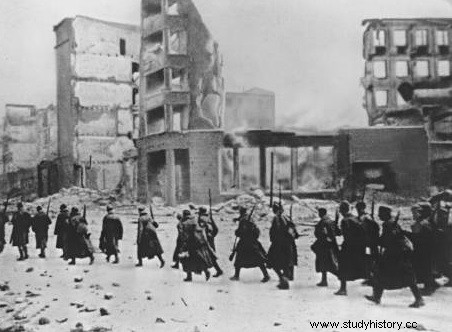 The Battle of Stalingrad , which opposed the German and Soviet armies from August 1942 to January 1943, is considered a turning point of the Second World War . Having become a symbol, this battle is one of the most significant episodes in the military history of the 20th century. This titanic combat in which the belligerents committed considerable resources ended with a decisive Soviet victory which halted the advance of the German armies in the Soviet Union. A stinging setback for the Axis powers, it constituted a precious psychological victory for the Allies.
The Battle of Stalingrad , which opposed the German and Soviet armies from August 1942 to January 1943, is considered a turning point of the Second World War . Having become a symbol, this battle is one of the most significant episodes in the military history of the 20th century. This titanic combat in which the belligerents committed considerable resources ended with a decisive Soviet victory which halted the advance of the German armies in the Soviet Union. A stinging setback for the Axis powers, it constituted a precious psychological victory for the Allies.
Beginnings of the Battle of Stalingrad
Since the invasion of the USSR on June 22, 1941 (Operation Barbarossa) and the initial successes of the German army, the front stabilized in December 1941. In spring of 1942, the German army has not yet recovered from the terrible fighting of the previous winter. Yet Hitler, who knows that time is against him, decides to launch a summer offensive against the Soviets. Its objective will be to deal a mortal blow to the USSR, by allowing (an old obsession of the Führer) to seize or neutralize the oil wells of the Caucasus (Maykop, Grozny and Baku). To do this, the Army High Command (OKH) is developing the Blue Plan (Fall Blau).
This plan grants an offensive mission only to Army Group South, which will have to operate according to the method that has so far worked so well for the Germans. Tanks and tactical aviation open the way, devastate the rear, ravage enemy logistics and command centers, the infantry follows and destroys the cauldrons thus created. The terrain chosen is that of the steppes and plains of southern Russia, from the Donets to the Volga, a vast charodrome where the German mechanical formations should be able to express all their power.
The Blue Plan must be implemented in several phases:
A:Two preliminary operations, the clearing of the Crimea by Von Manstein's 11th Army, and the reduction of the Izium Salient by the 6th Army and the 1st Armored Army.
I:Two pincers from Kursk and Belgorod will encircle the Soviet forces in the Voronezh region on the Don.
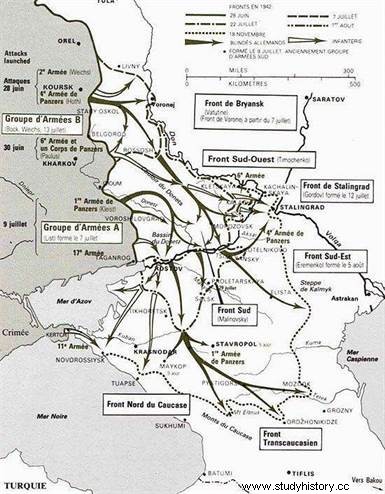 II:New encirclement of Soviet forces in the Millerovo region between Donets and Don. The engaged forces must then follow this river, towards the south.
II:New encirclement of Soviet forces in the Millerovo region between Donets and Don. The engaged forces must then follow this river, towards the south.
III:3 armies south of the system must rush east towards the Volga and join the forces engaged for phase II in the vicinity of the city of Stalingrad. The plan specifies "In any case, we must try to reach Stalingrad or, at the very least, to place this city under the action of our heavy weapons, in order to eliminate it as a center of armament and communication. The capture of Stalingrad is therefore not an objective in itself, it is rather a question of cutting off the river traffic on the Volga and of protecting the northern flank of the armies engaged for phase IV.
B:After completing the previous three phases and thus destroying most of the Red Army's presence in southern Russia, German forces will march into the Caucasus. This objective is assigned to Army Group A (from Army Group South) which must launch a motorized raid over more than 1000km to Baku. Another split from Army Group South, Army Group B will play sentinel on the northern flank along the Don and Volga rivers. The Stalingrad sector is assigned to the 6th Army.
The latter is an extremely powerful formation, from September 1942 it will even be the most powerful in the German Army (Heer). Then composed of 4 corps it includes 11 Infantry and Light Infantry Divisions (Hunters), 2 Motorized Divisions, 2 Armored Divisions (plus elements of another) and nearly 1000 artillery pieces including many rocket launchers multiple.
It is commanded by General Paulus, a Hessian born in 1890 into a family of minor civil servants. Entering the army in 1910, this very tall (1m93) although obscure lieutenant, joined aristocratic circles by marrying a Romanian noblewoman. This marriage will open many doors for her. Of fragile constitution, he served in staff offices throughout the First World War. He was then considered a gentleman, affable and measured, an excessive perfectionist and a good tactician. The rise to power of Hitler and the remilitarization of Germany gave a real boost to his career.
In 1935 he succeeded Guderian in the role of chief of staff of the direction of motorized troops. General in 1939 and Chief of Staff of the 6th Army, it was he who received the surrender of the Belgian army on May 28, 1940. After the campaign in France, he was one of the most prominent officers in the army. of land and became Quartermaster General. He will be one of the thinking heads of Operation Barbarossa. On January 5, 1942 he took command of the 6th Army. He who never directly commanded a brigade is now at the head of the pride of the army...
The failure of the Blue Plan
On June 28, 1942 the execution of the Blue Plan begins, the German army has 4 months to seize the oil wells of the Caucasus. In front of the German forces:a Soviet device certainly powerful, but secondary in the spirit of Stalin compared to the units committed in the region of Moscow. The Soviet leader feared that the Germans would once again attempt to encircle his capital, this time from the south. He considers the German preparations towards the Caucasus as a diversion. As a result, the first three phases of the Blue Plan are a relative success for the Germans.
As of July 25, they control Rostov (the gateway to the Caucasus) and are no more than a hundred kilometers from Stalingrad. However, on closer inspection, a German victory is far from certain. The Wehrmacht, which is no longer that of 1941, suffers from a crying lack of manpower and logistics struggles to keep up with the mad race of the armored divisions. Contrary to the campaigns of 1941, the Soviet units are increasingly able to evade the German encirclements and inflict heavy losses on the Heer, especially in urban combat.
Insidiously, the unfolding of the campaign and the hesitations of the German generals pushed Hitler to invest himself further in the conduct of operations, even if it meant going back to the main orientations of the Blue Map. Subjected to constant stress, the Führer, despite his solid strategic intuition, remains an amateur on the military level and gradually loses his sense of reality.
It was already clear by the end of July 1942 that the German forces were in no condition to conquer both the Caucasus and protect the northern flank (along the Don and of the Volga) of the forces which will be engaged there. Hitler, who refuses to stop the offensive, therefore decides to amputate army group B of part of its means to reinforce army group A.
The 6th Army which must secure the Stalingrad region finds itself having to manage a larger front (about 300 km) with fewer troops. Its fuel supply is also reduced, which slows down its advance towards its objective.
At the same time, the Soviets began to set up a defensive system around Stalingrad. Stalin understood that holding the city would allow him to exert a threat on the flank of the German offensive in the Caucasus. Establishing a fixation point in this way will give the Red Army the time necessary to prepare a counter-offensive.
 The front of the Battle of Stalingrad, created on July 12, will already line up 8 days later 187,000 men, 7900 artillery pieces and 360 tanks. The defense of the city falls mainly to the 62nd army soon commanded by Vassili Tchouikov.
The front of the Battle of Stalingrad, created on July 12, will already line up 8 days later 187,000 men, 7900 artillery pieces and 360 tanks. The defense of the city falls mainly to the 62nd army soon commanded by Vassili Tchouikov.
Originally peasant, a soldier like his 7 brothers, this brutally mannered and spirited officer knows how to stay close to his soldiers. In many ways he is the exact opposite of Paulus. Instinctive and daring, he hardly bothered with the doubts that frequently assailed his German adversary. This instinctive can count on an exceptional chief of staff:Krylov, an expert in urban combat famous for his calm.
The Battle of Stalingrad
Originally a simple secondary objective, the capture of Stalingrad ended up imposing itself on Hitler as a priority. Realizing that his forces engaged in the Caucasus may not be able to achieve victory, he hopes at least to seize this great armament center, which commands the Soviet supply routes from north to south, along the Volga. . In addition to these logistical and industrial considerations, there is a psychological and political factor. Second Reich propaganda called for victories, and what a brilliant victory the capture of the city that bears Stalin's name would be!
A Stalin who also understood the importance of the city and who was ready to sacrifice a large number of men there. The progress of the 6th Army towards Stalingrad is slow and difficult. In addition to fierce Soviet resistance, there are many logistical problems and the hesitations of Paulus. The Luftwaffe (and in particular the 4th air fleet of Von Richthofen) however weakened, provided a maximum effort. On August 23, it even destroyed a large part of the city (killing tens of thousands of civilians), transforming it into a field of ruins. Ruins in which the Soviet soldier will be able to fight admirably...
The German attack on the city began on September 13, 1942. The bulk of the fighting was concentrated only on a front of ten kilometers as the crow flies. Paulus assigned his troops two main objectives:
1/ The Mamayev Kurgan an artificial hill (an ancient Scythian burial) 102 meters high which gives an excellent view of the Volga and the northern part of the city (the district large factories)
2/ The central wharf on the Volga which is the main route for the delivery of reinforcements and supplies for the Soviet armies fighting in the city center (62nd and 64th armies ).
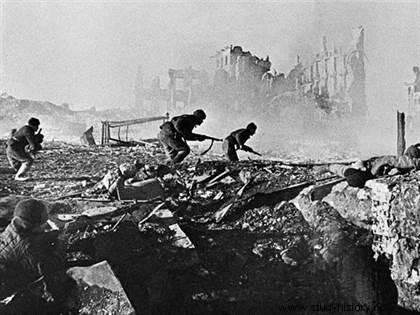 Paulus experienced in major motorized operations in the open country, tries to apply the methods to a field quite different. At first, the deluge of fire that falls on the Soviets seems to have to break all resistance. Tchouikov, who repeatedly fails to be killed, even thinks for a time that the city is lost.
Paulus experienced in major motorized operations in the open country, tries to apply the methods to a field quite different. At first, the deluge of fire that falls on the Soviets seems to have to break all resistance. Tchouikov, who repeatedly fails to be killed, even thinks for a time that the city is lost.
Nevertheless in the street fights, in the middle of the rubble, in the cellars and floors of half-collapsed buildings, the Soviet soldier demonstrated a great capacity for resistance. Entire battalions clash for a block or a factory in a deadly ballet. In one week, the station district changed hands 15 times! German tanks proved vulnerable to mines, improvised explosive devices and anti-tank guns. The snipers on each side compete in audacity and there are countless attacks with knives...
After two months of merciless battle, marked by incredible sacrifices (some Soviet divisions disappear in 24 hours) Paulus holds 90% of the city. In mid-November 1942, Chuikov's 62nd army had only 47,000 men and 19 tanks and was split into three groups. The central wharf and the Mamayev kurgan are still holding, but the units defending them are decimated and exhausted. The sanitary conditions are appalling, hundreds of wounded are dying without hope of treatment and the ammunition is almost exhausted.
Stalingrad seems doomed and yet Chuikov knows she will not fall. Indeed, on the 19th, Operation Uranus will begin...
Uranus and the encirclement of the 6th Army
Operation Uranus was the great counter-offensive of the Red Army for 1942. It was conceived in September 1942 and benefited from methodical planning of high quality . In many respects, it evokes the grand style offensives of the Wehrmacht. It is a double encirclement (north and south) of the German forces engaged in Stalingrad, with great reinforcement of artillery, tanks and aviation.
Gueorgui Zhukov, the architect of this operation, manages in two months to achieve an exceptional feat. He concentrated about a million men, 900 tanks, 13,500 artillery pieces and more than a thousand planes in the sector assigned to the operation and all while concealing his intentions from the Wehrmacht. German intelligence, despite numerous alerts, did not want to believe in the success of a Soviet offensive.
And yet, where the bulk of the Soviet attack will be, the Axis defenses are very weak. The 6th Army, on Hitler's orders, is still engaged in the fighting at Stalingrad, and its flanks are held by formations with questionable defensive capabilities. The initial efforts of the Soviets will bear against Romanian divisions whose soldiers are ill-equipped and less motivated than their German counterparts. These formations hold large sectors, disproportionate to the weakness of their anti-tank means.
At 7:30 a.m. Moscow time, upon receiving the code word "Siren", an 80-minute bombardment begins to fall on the positions of the Romanian Third Army (7 divisions), which protects the northern flank of the 6th army of Paulus. At 8:50 a.m., three Soviet armies launched an assault on the Romanian lines, severely shaken by the preceding deluge of fire (which was said to have been heard from 100 km away). At the end of the day 27,000 Romanian soldiers will have been taken prisoner, and the Germans will have already lost the remains of the 22nd Armored Division, sent to the rescue of the Romanians. Barely 3 days later, the two pincers of the Soviet encirclement meet at Kalatch, trapping Paulus' army in a pocket just over 60 kilometers wide. In total, 260,000 men (including 9,500 Romanians), 140 armored vehicles and some 1,250 guns were trapped.
The army of Paulus at the cost of great sacrifices managed to keep control of several airfields on which its supply depends. However, she is already no longer fit for anything other than defense. Gasoline is running out, the tanks are at a standstill and ammunition is scarce. The 6th Army, cut off from its rear and its depots, is completely lacking in terms of logistics. This situation immediately dooms any attempt at independent exit to failure. Paulus has to hold on until someone comes to help him free himself.
The agony of the German 6th Army
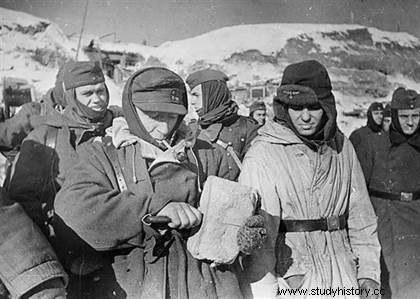 Hitler is indeed confident in the resistance capabilities of the encircled troops. The head of the Luftwaffe Goering assured him that an airlift can make it possible to supply the 6th army. Even Marshal Von Manstein, called to the rescue by the führer, is optimistic. After all, hadn't the Luftwaffe succeeded in saving the Demyansk pocket where 100,000 German soldiers had been trapped the previous winter?
Hitler is indeed confident in the resistance capabilities of the encircled troops. The head of the Luftwaffe Goering assured him that an airlift can make it possible to supply the 6th army. Even Marshal Von Manstein, called to the rescue by the führer, is optimistic. After all, hadn't the Luftwaffe succeeded in saving the Demyansk pocket where 100,000 German soldiers had been trapped the previous winter?
The 6th Army must hold on thanks to the airlift, while Manstein takes care of gathering the forces necessary for its release.
The airlift, however, turns out to be a disaster. The Luftwaffe would have to deliver 350 tons to the Sixth Army every day to keep it going. Goering's men will barely reach an average of one hundred tons a day. The transport planes are not numerous enough, the maintenance does not follow and the aerodromes of the region are too small. As for the Soviets, they fiercely defend the skies around Stalingrad with the help of a powerful DCA.
Thus the situation of the troops within the pocket is getting worse day by day. Hunger torments the soldiers, who in addition to saving their ammunition have to deal with the harsh Russian winter. Frostbite and disease decimated units engaged in the face of increasingly daring Soviet troops.
As for Manstein's rescue operation called "Wintergewitter", it does not look very auspicious. The plan is simple and brutal. The 4th Armored Army must jostle the Soviet troops guarding the southwest of the pocket while at the same time the 6th Army must engage its mobile forces against them, while holding its positions elsewhere.
Hitler does not intend to abandon Stalingrad but rather to hold it with the help of a corridor, since it must serve as a starting point for the offensive he is planning in 1943. Manstein opposed this vision, preferring a withdrawal of the 6th Army outside the city. Convinced that he would be able to convince Hitler of the correctness of his views in the heat of the moment, he launched Operation Winter Storm on December 12.
Although during the first days the German armored forces enjoyed great success, Manstein understood that the operation was doomed to failure. The Soviets launched Operation Saturn on December 16. The latter struck the left flank of Manstein's forces and risked encircling them. The Marshal's only ambition now is to save his own troops in order to avoid an even greater disaster.
The Battle of Stalingrad, a turning point in the war
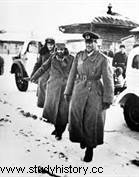 Paulus, undermined by his failure to capture the city and like his men weakened by deprivation, n didn't know, couldn't or didn't dare attempt a forceful exit. This, if indeed it could have succeeded, could only have been achieved by abandoning the positions so dearly won at Stalingrad, which Hitler absolutely refused to do. The men of the 6th army who starve to death (all the horses of the army having been eaten by this date) are now doomed.
Paulus, undermined by his failure to capture the city and like his men weakened by deprivation, n didn't know, couldn't or didn't dare attempt a forceful exit. This, if indeed it could have succeeded, could only have been achieved by abandoning the positions so dearly won at Stalingrad, which Hitler absolutely refused to do. The men of the 6th army who starve to death (all the horses of the army having been eaten by this date) are now doomed.
Their ordeal will last even more than a month. The German units will try to resist the Soviet coup de grace:Operation Koltso. Gradually, the divisions of the 6th Army retreated, giving up control of the airfields that connected them to the outside world. Hitler and Manstein who know well that the situation is hopeless, enjoin Paulus and his men to hold out as long as possible. Their sacrifice must immobilize many Soviet forces and give time to the German troops engaged further south to withdraw and escape encirclement.
In order to urge Paulus to refuse any capitulation Hitler even grants him the baton of marshal. He hopes to lead him to suicide (so far no Feldmarshall has ever surrendered) and thus galvanize his troops. Troops who are nothing more than specters in rags, who already and on their own initiative, surrender to the Soviets...
January 31, 1943 Paulus, who had not been directing operations for a week, surrendered. In reality, in the midst of a depression, he did not even participate in the capitulation negotiations, carried out by subordinates determined to save what could still be saved. The Red Army takes more than 100,000 prisoners. The latter are taken and then interned in internment camps in appalling conditions. 17,000 will have died by February 1943, only 5,000 will one day return to Germany. The Red Army would not even have had enough to feed them properly anyway...
A mythical fight mythologized by Soviet propaganda, the victory at the Battle of Stalingrad immediately had worldwide repercussions. A national disaster for the Germans, it has long been considered a turning point in the Second World War. Yet after this the Wehrmacht will hold another 26 long months against the Red Army. Proof if there is one that despite its extremely serious nature, it could not on its own constitute a turning point in the war.
Nevertheless it was in the destroyed streets of the city, by the torrents of blood that will have been shed in its defence, by the prodigies deployed to encircle the 6th Army there that the Soviet forces will have learned the cruel lessons necessary for their eventual victory.
Non-exhaustive bibliography
• Anthony Beevor, Stalingrad, Editions de Fallois, 1999.
• Jean Lopez, Stalingrad, the battle on the edge of the abyss, Economica editions, Coll. Campaigns &Strategies, 2008
To go further
- Great Battles:The Battle of Stalingrad. Documentary, DVD, TF1 Editions, 2005.
- Stalingrad by Jean-Jacques Annaud. Fiction, DVD, Pathé, 2002.
